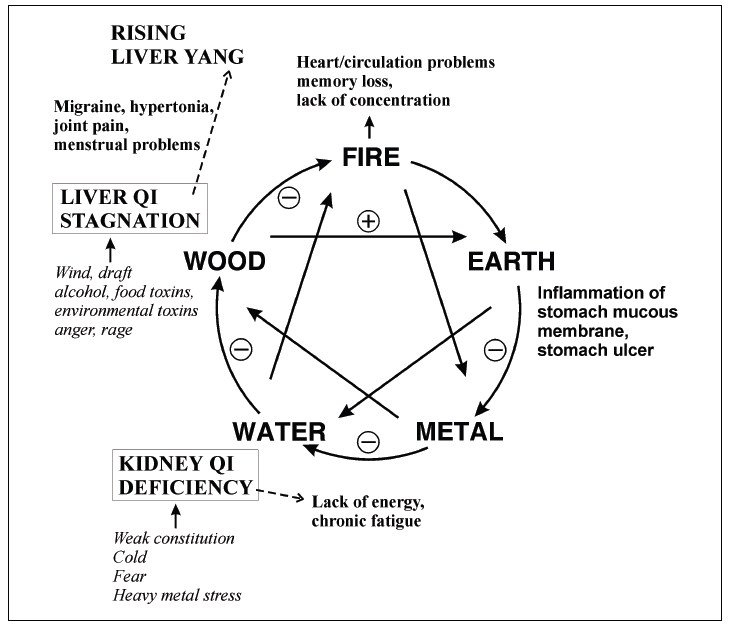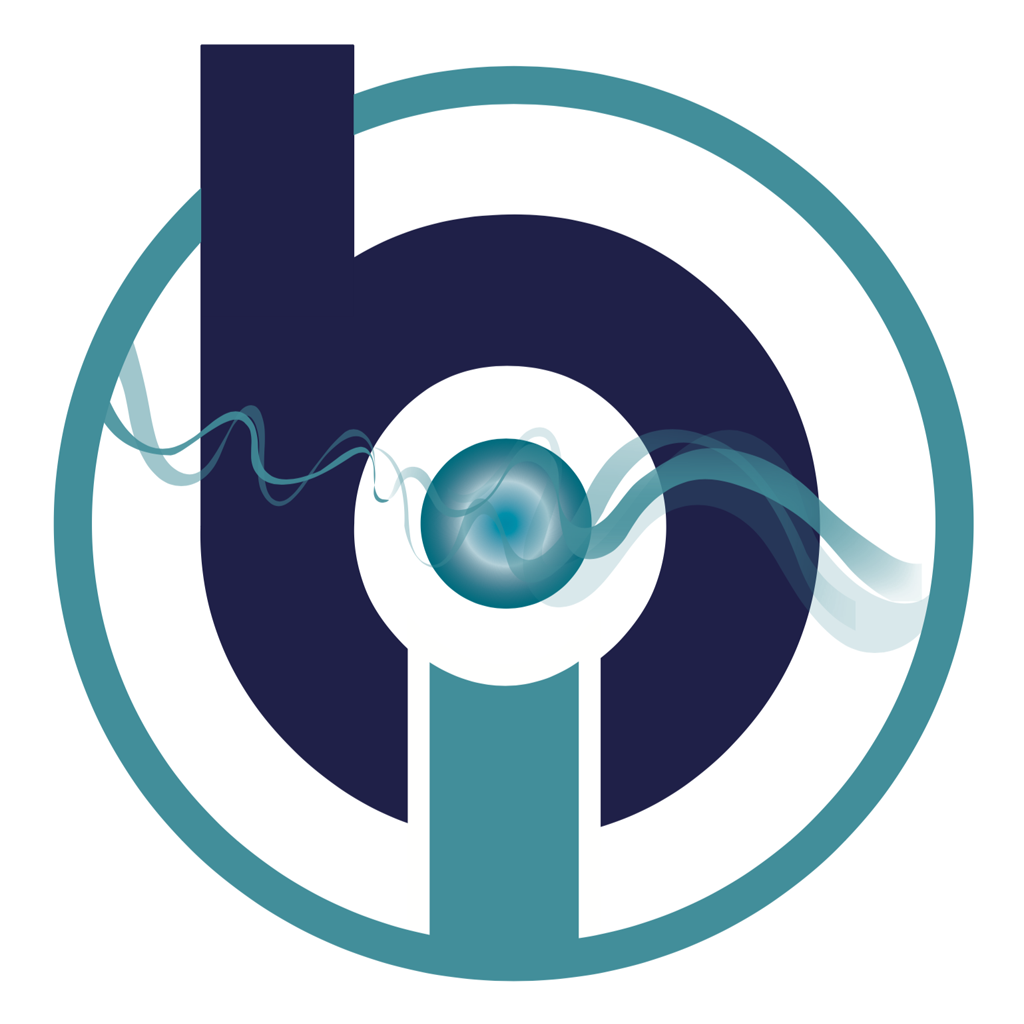Dr. med. Jürgen Hennecke, Aachen
1. INTRODUCTION
Around 5 % of the adult population suffers from bronchial asthma. Those affected by it are becoming increasingly younger: up to 15 % of children suffer from this disorder, with bronchial asthma the most common chronic disorder in childhood. Boys are twice as likely to be affected as girls. In one third of children initial symptoms appear in the first year of their life. Conventional medical treatment is confined to treating the symptoms, which is very effective in itself but seldom tackles the cause of the disorder. BRT provides us with an excellent opportunity for therapy.
2. DEFINITION
“Bronchial asthma is an inflammatory disorder of the airways with bronchial hyperreactivity and spasmodic obstruction of the airways, usually connected with an atopic disposition.”
A differentiation is made in conventional medicine between chronic bronchitis and bronchial asthma. Our experience has shown that the same approach works for both clinical pictures. Chronic sinusitis is also a chronic disorder of the airways and often appears in combination with bronchial asthma. The same criteria for diagnosis and therapy also apply here. Depending on the severity of the symptoms bronchial asthma is divided into 4 stages, with corresponding differences in conventional therapy recommendations and indeed the intensity of BRT treatments (Table 1, see page 5).
3. CAUSES AND DIAGNOSIS
In conventional medicine a differentiation is made between the following forms of asthma: • Intrinsic bronchial asthma (genetic, constitutional or cause unknown!)
• Allergic bronchial asthma
• Infection-induced and chemical toxic bronchial asthma
• Stress-induced bronchial asthma
Often the causes or triggers may be found or suspected by taking a careful case history and should then be included in our energetic diagnosis. In the energetic diagnosis using EAV, tensor or kinesiology, for every chronic disorder we first look for basic energetic stresses and then other general or organ-related stresses.
Basic stresses
Table 2
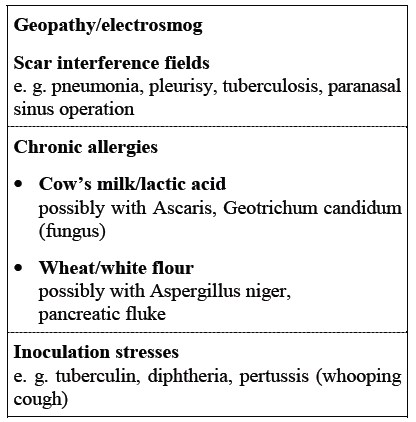
In addition to testing for geopathy and electrosmog (also as a consequence of frequent x-ray diagnosis) we are keeping an eye out for scar interference fields (especially in the paranasal sinuses and dental areas, but also as residues of pneumonia or pleurisy).
Cow’s milk and wheat are also the most frequent chronic allergies in bronchial asthma cases. They often (but not always) occur in conjunction with parasitic stresses. In the case of a cow’s milk allergy the symptoms often include increased mucous formation (high levels of phlegm containing sputum and secretions) while wheat allergies generally cause dry mucous membranes with a chesty cough. It is important to always look for inoculation stresses and chronic heavy metal stresses. Even if this dates back to the past, years of exposure to chemical stresses (especially wood preservers and formaldehyde) in rooms in the home or at work damage the bronchial mucous membrane and the immune system.
Organ-related stresses
Table 3
Stresses in the lungs and bronchial tubes with:
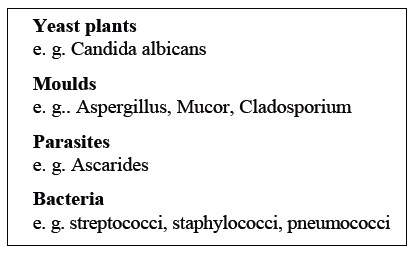

In addition to allergic-toxic stresses of the mucous membranes we often find direct contamination in the bronchial tubes with yeast and moulds, parasites, viruses or bacteria. Use of inhaled corticosteroids limits the inflammatory reaction but can cause the germs to spread and grow and may even cause the disorder to become chronic.
“Acute” allergic stresses (Table 4)
A variety of inhaled allergens can represent both a chronic, permanent irritation of the bronchial tubes (house dust, mould, environmental toxins) or trigger seasonal complaints (pollen, mould) as well as triggering acute asthma attacks (mould, animal hair, fragrances). Food allergens which are consumed orally may also trigger asthma attacks.
Table 4
Acute allergies
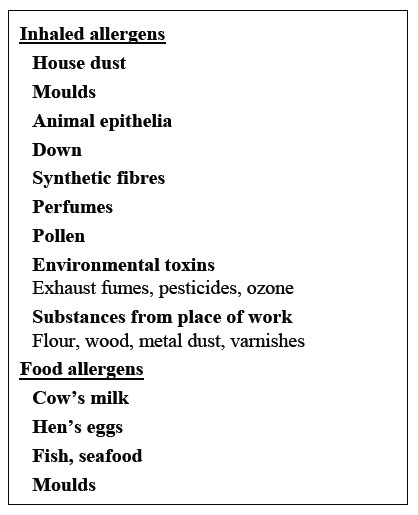

4. GENERAL MEASURES
Changes in surroundings
Recommendations made by conventional medicine such as avoiding allergens (cleaning to remove house dust, changing place of work, removing pets, long-term diets) are great in theory but often don’t work in practice. Normally this is not necessary anyway since the allergies we treat are usually accessible.
It is important for our therapy that the living area is cleared of radiation stresses and there is a temporary change in diet during intestinal clean-up and treatment for food allergens. Areas in the home or at work where there are high levels of mould or toxin stress should be avoided or cleaned. Tobacco smoke is poison for the bronchial mucous membranes. BICOM therapy again offers us a valuable opportunity here to help motivated patients to stop smoking.
Medication
Conventional medication should not be discontinued at the start of treatment under any circumstances! Even though cortisone hinders the ability of the organism to regulate itself, BICOM therapy can still be applied successfully even with this medication. Only after symptoms clinically improve can the medication be slowly phased out and discontinued altogether. Homeopathic drugs, both individual and complex, probiotics, orthomolecular substances may be used depending on the test results and the experience of the therapist.
5. BIORESONANCE THERAPY
Table 5
BICOM therapy for bronchial asthma
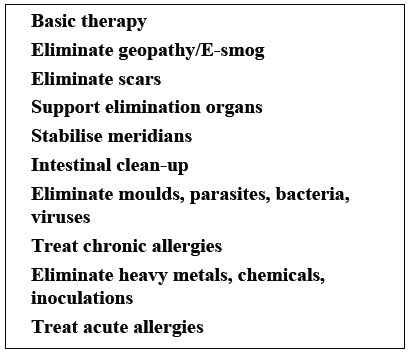

After the tested basic therapy the main blocks such as radiation stress (programs 700, 701, 702) and scar interference fields (programs 910, 900) are treated.
The elimination organs and meridians may be supported via the corresponding therapy programs or the CTT ampoules. This can often affect the “water” element as well as the “metal” element. An intestinal clean-up is often necessary since the mucous membranes in the intestine and airways are energetically linked to one another (“metal” element). Mould ampoules and swabs (Ai program) and mould medication (A program) may also be oscillated at the same time on the intestine, lung and paranasal sinuses.
The elimination of germs, inoculations, heavy metals and toxins takes place via the allergy therapy program with individually tested amplifications and therapy times. Allergy therapy for chronic and acute allergies is carried out using known therapy programs according to criteria provided in the seminars.
When selecting allergens, in addition to tested ampoules and Multisoft information the original substances found in the home or workplace or from outside are also used. The more precisely the information matches the therapy substance with the actual patient stress, the better the therapy results.
Where symptoms persist despite specific allergy treatment we have often had more success with therapy using a strip of sellotape which hung for several days in the home or place of work or in the open air. The coming together of several potentiating stresses may play a deciding role here. In the case of acute pollen allergy we often use our environmental toxin mix (Table 6).
Table 6
”Environmental toxin mix”
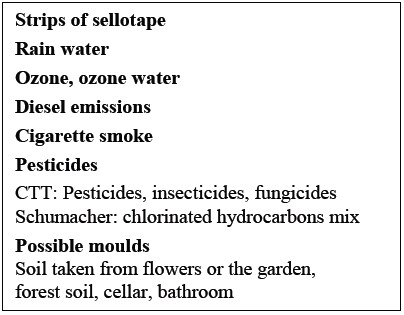

Caution! There are sensitive asthmatics who often suffer a bad initial reaction after the first few hours (increased spastic paralysis, asthma attacks).
This happens more frequently when treating moulds and possibly also when treating acute pollen allergy. The modulation mat often has to be switched off in this situation (balls, foot plates and flexible applicators used instead) and the programs must be balanced in terms of amplification and therapy time. Program 127 has proven effective in preventing over-reaction. The chip may also have to be removed or the BICOM Minerals and oils reduced or discontinued.
Further proven BICOM programs:
210, 211 Lung meridian
423, 240, 800 Bronchitis, pneumonia
422 Vital capacity
970 Detoxication
530 Metabolism
900 Vitality
A potentiation of the body’s own secretions (blood, saliva, sputum) may be used and run to complement the aforementioned therapies. Usually H+Di is used in potentiation stages D12, D30, D200 or D1000.
Asthmatic symptoms after a stress to the body (asthma as a result of over-exertion) usually improve following treatment of the chronic allergies or environmental stresses. If this is not the case, lactic acid (metabolic product following muscle work) and ascorbic acid should be tested and treated. Oversensitivity to the body’s own stress hormones, such as adrenaline and cortisone, can also play a part.
6. PSYCHOSOMATIC ASPECTS
It can often be deduced from the case history that the appearance of asthma and allergies are linked to separation conflicts or the fear of separation (death, separation from partner, children, pets, moving house, school or job). Relaxation techniques, breathing therapy, therapeutic discussions, kinesiological balances and Bach’s flower therapy are useful support measures. Chakra therapy often helps. Breathing is controlled using the 4th chakra (larynx chakra).
7. CASE STUDIES
Case 1: R. R., female, aged 3
For 1 ½ years initial endogenous eczema followed by bronchial asthma. Medication from paediatrician: Frenopect, Spiropent, Cromohexal, Atrovent, Salbutamol, Rectodelt.
Test results
Allergy to wheat, house dust, Aspergillus mix and mercury stress (amalgam from mother?).
Therapy
(Sept.-Oct. 1998, Nov. 1999; 9 treatments in total)
Basic therapy, toxin elimination via saliva (999), metabolism (530)
1x mercury elimination
3x allergy therapy wheat
2x allergy therapy house dust
3x allergy therapy Aspergillus (with sellotape brought from home)
Following this, no more eczema or asthma (or medication) to date!
Case 2: R. B., female, aged 46
Since 1993 (following pneumonia) year-round bronchial asthma and pollinosis (March – September). Medication: Atmadisc, Salbutamol, Nasonex.
Test results
• Scar interference fields left lung, right ear, lumbar spine
• Allergies: cow’s milk, tomatoes, peppers, hazel nut, house dust, Aspergillus, cat, dog, perfume mix, chlorinated water, early bloomers, grasses and wheat pollen
• Stress from Xyladecor
Therapy (14 treatments in total)
Basic therapy, scar interference 910, detoxication 970, metabolism 530, lung 210, 240
2x cow’s milk
2x house dust
2x hazel, willow, birch
3x grasses and grain pollen
1x chlorinated water
1x perfume mix
1x Xyladecor
1x environmental sellotape and car emissions
After this treatment virtually symptom-free. Salbutamol spray used only (rarely) as required!
Case 3: R. L., female, aged 51
Bronchial asthma (all year round) for 12 years, chronic sinusitis, susceptible to infection, animal hair allergy. Medication.: 10 mg cortisone orally, Salbutamol DA.
Test results
Scar interference fields: condition post strumectomy.
Condition post hysterectomy, condition post breast surgery (both breasts).
Allergies: wheat, house dust, mould, perfume, cat, dog, E 216, E 218.
Therapy (16 treatments in total)
Basic therapy, scar interference, detoxication 970, lungs 210, 234
3x wheat
3x house dust
3x mould 1, Aspergillus mix
3x cat
3x dog
1x perfume mix, E 216, E 218
1x Epstein-Barr virus
Feels much better, no more cortisone, inhaler used as required (rarely)!
Case 4: R. R., male, aged 50
For 2 years allergic bronchial asthma, especially at work (wholesale florist), has difficulty breathing when in contact with hyacinths, lily of the valley, chrysanthemums, amaryllis …
Medication: Viani, Foradil.
Test results
Scar interference field: left lung (pneumonia).
Allergy: cow’s milk, mould, methoxychlor.
Stress: pneumococcal.
Therapy (8 treatments in total)
Basic therapy, scars 910, detoxication 970, liver 430, lungs 210, 240
2x cow’s milk
2x Methoxychlor and sellotape from florist
2x mould 2, Aspergillus mix
1x pneumococcal
He feels a lot better, no more difficulty breathing at work, medication taken (rarely) as required!
Case 5: T. P., male, aged 25
Confectioner, due to take over family business. For 6 months (following renovation work, mould?) bronchial asthma and allergic conjunctivitis in the shop (flour dust).
Medication: Salbutamol DA, Xusal, Telfast, Cortisone injections.
Test results
Allergy to cow’s milk, wheat, flour dust, mould, house dust.
Therapy
Basic therapy, detoxication 970, lungs 210, 240
3x wheat, flour dust and sellotape from the bakery brought in by patient
3x cow’s milk
3x moulds
2x house dust
He feels a lot better, no more difficulty breathing at work, no medication, will indeed be taking over the family business…
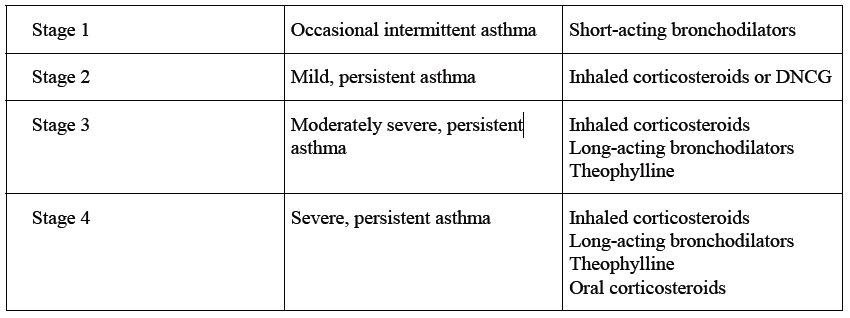

Division into stagestherapy
